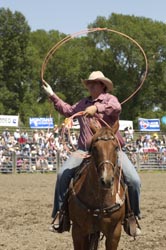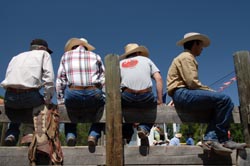Rodeo
Updated: August 18, 2020

We don't know a great deal about Montana's first cowboys, but chances are they arrived from Texas shortly after the Civil War, around 1886. Nelson Story was one of Montana's first trail bosses. He made a fortune mining gold in Virginia City and used his earnings to buy 1,000 Texas longhorn cattle. He then hired 24 war weary drovers (probably ex-Confederate soldiers) with the intention of driving the herd to Kansas where they would be sold and shipped east. The drovers were cowboys by trade, having learned the business from Mexican vaqueros. The design of their boots and hats, along with their saddles and equipment, all borrowed heavily from the Spanish.
When the cattle drive reached Kansas, they were set upon by a gang of Jayhawks (leftover Civil War outlaws), who demanded four-dollars a head to let the cattle pass. Rather than pay the ransom, Story turned his herd toward Montana where, after an memorable journey plagued with drought and Indian attacks, he settled near the junction of the Sheilds and Yellowstone Rivers.
Like Story's, many other cattle companies were established on the open range of Montana. Cowboys were proud of their abilities as horsemen and took great pride in the quality of their saddles, reins, bits, and spurs. They maintained the herds of longhorns on the open range. Early Montana cowboys relied on wild mustangs for their mounts.

These horses were descended from the earliest stock introduced by the Spanish. A special cowboy, known as the wrangler was responsible for the "remuda," or extra horses. Each cowboy was given a string of six to twelve horses, depending upon his work. He changed mounts when one animal was tired or when he needed a horse with special skills. Once a horse was assigned to a cowboy, he was responsible for its training. Cowboys broke the wild horses by riding them out, that is, staying on their backs until they stopped bucking. Many horses remained half-trained or rank, resulting in a bucking contest before work on the range could begin.
Occasionally, a horse came along that couldn't be ridden. Bronc busters from other outfits or cattle companies were challenged to try their luck on the horse. Eventually, at casual get-togethers, top hands from neighboring ranches would show off their work-a-day skills, not only bronc riding, but also calf roping and steer wrestling. Although steer riding served no useful purpose, it was dangerous and exciting to watch and was often tried on a dare or a bet. Rodeo grew out of these informal challenges between cowboys who met on roundup or on the trail.
In the early twentieth century, riding and roping began to evolve from occupational activities to spectator sports. The period from WWI to WWII was the development period for the unique American entertainment we call rodeo. In small towns from Texas to Canada rodeos became the main attraction at fairs and local celebrations. Many of the first rodeo performers were nostalgic cowboys missing their adventurous past. The first paying customers were farmers who had ended the cowboy way of life. Eventually, rodeo grew larger and developed into marquee events such as the Calgary Stampede, Cheyenne Frontier Days, and headlined Madison Square Gardens in New York City and the Cow Palace in San Francisco.

Today there are six standard rodeo events: bareback bronc riding, saddle bronc riding, bull riding, steer wrestling (bull dogging), and calf roping. Team roping is another specialized event. Women participate in the barrel race. The field often competes for thousands of dollars in events sanctioned by the Professional Rodeo Cowboys Association or the Northern Rodeo Association. In Montana, you can also find Ranch Rodeos, Old Timer Rodeos, Indian Rodeos, Youth Rodeos (College and High School) and Team Roping Events.
In the riding events the contestant must stay on the animal for 8 seconds, while holding on with one hand. Riders are disqualified if they fall off or touch the animal with their free hand. Judges award points based on the performance of the animal as well as the rider. In bareback bronc riding, the rider must hold on to a special rigging mounted just behind the horse's shoulders while the horse bucks wildly. Riding saddle bronc is similar except the rider holds on to a single halter rope and sits on a special light saddle. Bull riding is the most dangerous of all rodeo events. Bulls often weigh one ton and are amazingly quick. The rider holds on to a flat braided rope that has been placed around the bull, right behind his shoulders, and then wraps the rope around his hand. The bull is then turned loose in the arena.
Calf roping, steer wrestling, and barrel racing are timed events. In calf roping the cowboy on horseback must rope the calf, dismount, and tie three legs of the calf with a pegging string. The rider then remounts, loosens the rope, and waits for five seconds to see if the calf escapes. If the calf does free itself, the cowboy is disqualified. (This is similar to how calves are captured for branding.)
In steer wrestling, a rider leans from a running horse over the back of a steer, catches its horns, slides from his horse onto the ground, stops the steer and wrestles him to the ground. The bulldogger is assisted by a hazer also on horseback, who keeps the steer running straight. In barrel racing, the rider races their horse around barrels set in a cloverleaf pattern.
Almost from the beginning there has been the rodeo clown, often the most talented and versatile person in the arena. The main job of the clowns is to protect the cowboys. Comically praying over a fallen rider or romping mock-heroically behind a steer already headed for the exit gate, the clown has assumed the function of the safetyman. There are three different categories of clowns: bull fighter, barrel man, and clown. They all try to distract the bull long enough for the rider to escape the arena without injury. With the magic of their bright costumes, rags a flutter, silly hats and using brightly colored barrels and inner tubes the clowns can distract a dangerous bull from an injured rider or help a snared rider get out of his saddle. They also help keep the audience amused during the rodeo with skits and jokes.
Rodeo is a Spanish word meaning roundup. Many of the earliest rodeos in Montana followed the autumn roundup. Today you can see a rodeo in almost any month of the year.
Premier Montana events include:
- NILE Bull Riders Invitational in Billings
- Wolf Point's Wild Horse Stampede
- Home of Champions Rodeo in Red Lodge
- American Legion Rodeo in Augusta
- Fourth of July in Ennis
- Miles City Bucking Horse Sale
- Last Chance Stampede in Helena
- State Fair in Great Falls.
Updated: August 18, 2020

